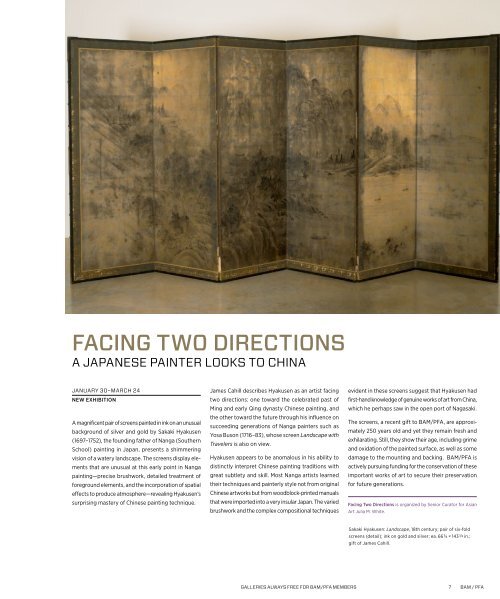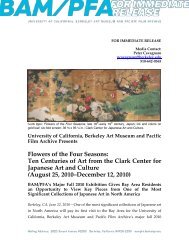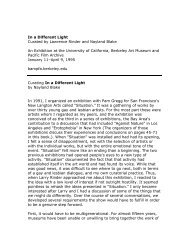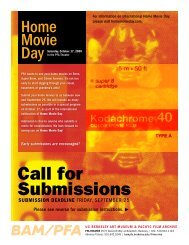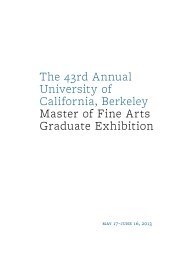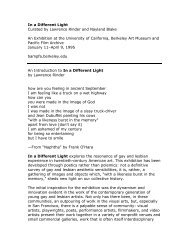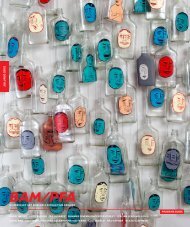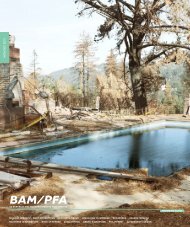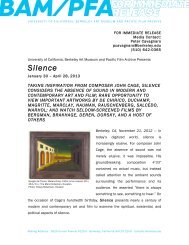January & February 2013 - Berkeley Art Museum and Pacific Film ...
January & February 2013 - Berkeley Art Museum and Pacific Film ...
January & February 2013 - Berkeley Art Museum and Pacific Film ...
- No tags were found...
You also want an ePaper? Increase the reach of your titles
YUMPU automatically turns print PDFs into web optimized ePapers that Google loves.
EXHIBITIONSFacing Two DirectionsA Japanese Painter Looks to China<strong>January</strong> 30–March 24New ExhibitionA magnificent pair of screens painted in ink on an unusualbackground of silver <strong>and</strong> gold by Sakaki Hyakusen(1697–1752), the founding father of Nanga (SouthernSchool) painting in Japan, presents a shimmeringvision of a watery l<strong>and</strong>scape. The screens display elementsthat are unusual at this early point in Nangapainting—precise brushwork, detailed treatment offoreground elements, <strong>and</strong> the incorporation of spatialeffects to produce atmosphere—revealing Hyakusen’ssurprising mastery of Chinese painting technique.James Cahill describes Hyakusen as an artist facingtwo directions: one toward the celebrated past ofMing <strong>and</strong> early Qing dynasty Chinese painting, <strong>and</strong>the other toward the future through his influence onsucceeding generations of Nanga painters such asYosa Buson (1716–83), whose screen L<strong>and</strong>scape withTravelers is also on view.Hyakusen appears to be anomalous in his ability todistinctly interpret Chinese painting traditions withgreat subtlety <strong>and</strong> skill. Most Nanga artists learnedtheir techniques <strong>and</strong> painterly style not from originalChinese artworks but from woodblock-printed manualsthat were imported into a very insular Japan. The variedbrushwork <strong>and</strong> the complex compositional techniquesevident in these screens suggest that Hyakusen hadfirst-h<strong>and</strong> knowledge of genuine works of art from China,which he perhaps saw in the open port of Nagasaki.The screens, a recent gift to BAM/PFA, are approximately250 years old <strong>and</strong> yet they remain fresh <strong>and</strong>exhilarating. Still, they show their age, including grime<strong>and</strong> oxidation of the painted surface, as well as somedamage to the mounting <strong>and</strong> backing. BAM/PFA isactively pursuing funding for the conservation of theseimportant works of art to secure their preservationfor future generations.Facing Two Directions is organized by Senior Curator for Asian<strong>Art</strong> Julia M. White.Sakaki Hyakusen: L<strong>and</strong>scape, 18th century; pair of six-foldscreens (detail); ink on gold <strong>and</strong> silver; ea. 66 ¾ × 143 3/8 in.;gift of James Cahill.GALLERIES ALWAYS FREE FOR BAM/PFA MEMBERS7 BAM / PFA


